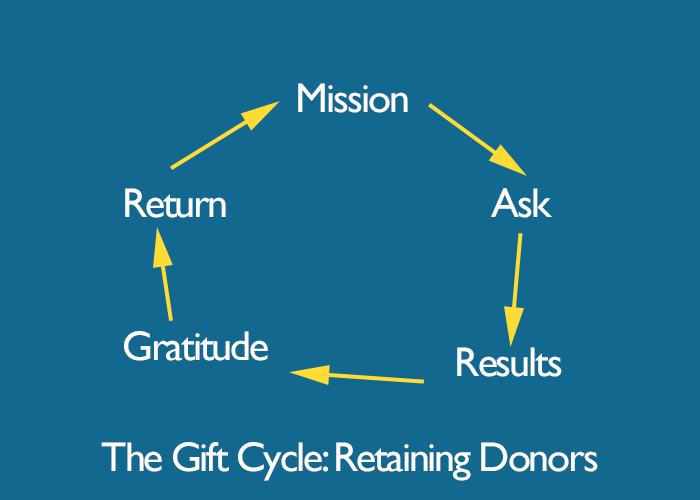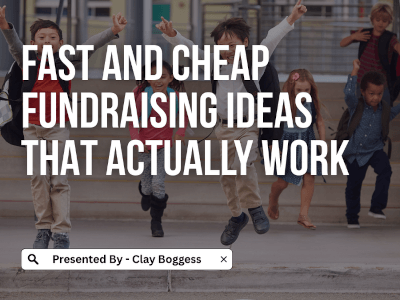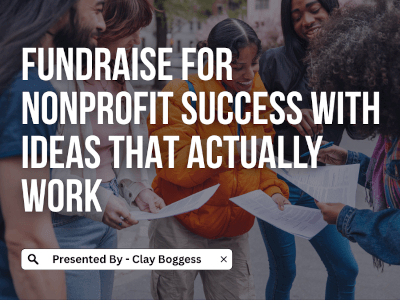
Learn how sharing impact and gratitude can raise more money.
Raising more money for your school or sports team can be daunting. Year after year, it can feel like your fundraising efforts have you tapping the same well, and you might be worried you'll exhaust your supporters.
People will be solicited for donations countless times over a year. The best fundraisers and development experts know that despite this statistic, you can still have a highly successful fundraiser if you commit to combating exhaustion with inspiration.
Expert fundraisers Sarah Clifton, and Deborah Kaplan Polivy discuss the model of the "gift cycle," a fundraising concept that translates well into any setting looking to generate gifts on a periodic or annual basis.
The gifting cycle or "donor lifecycle" essentially describes the relationship between fundraiser and donor or customer and refers to the process of informing donors about your mission; making "the ask", communicating results; expressing gratitude; and returning later for renewed commitment.
For schools, sports teams, and other community organizations trying to raise money, this annual ask may very well be a door-to-door conversation with your friends and neighbors, which makes donor stewardship an essential component of any sized fundraising campaign.
Depending on the scale of your fundraising, the "gift cycle" may not be as protracted, and the time for cultivation can be limited. However, that doesn't mean you should skip these steps because your elementary school fundraiser isn't as large as your local United Way campaign. Treat fundraisers for community groups like nonprofits treat their corporate fundraisers, and you'll be far more likely to raise a lot of money and keep your community engaged in your cause for more than one season.
The key is cultivating relationships with those who support your community organization by closing the gap between buying a fundraising product and the impact that these contributions will make.
Consider that a student will likely be a sports team or school member for three to five years, if not longer. We know that teachers are spending more than ever on critical instructional supplies. Most community organizations will face annual fundraising needs to help supplement the cost of materials, equipment, or other programs. Fundraising may be integral to their participation over a student's tenure in one of these groups. Perhaps these fundraisers will even offer students skill-building opportunities and rewards.
To help maximize the impact of your fundraiser and raise big money, consider cultivating donors by defining your fundraising mission, communicating the impact a successful fundraiser will make, and expressing gratitude to donors for helping you or your school, church, or other organization raise money. Building trust, rapport, and investment with your community will improve the likelihood that people will become champions of your organization and be willing to support your fundraising goals year after year.
Here's what your fundraising strategy should include to master the gift cycle.
Successful Fundraising Strategies Are Mission-Driven
Jason Saul, CEO of Mission Measurement and author of "The End of Fundraising: Sell Your Impact," briefly describes the transformation that has led to a revolution in how all fundraisers must approach their donors.
"The worsening of social and environmental conditions has bolstered interest in the social capital market. Today, social change is no longer exogenous to our economy," writes Saul. "[That] means that the "product" that nonprofits manufacture—social impact—now has mainstream economic currency.
This is especially true for brochure fundraisers and other turnkey development solutions. When your fundraising strategy has a product at the core of its operation, you must connect this product to the excellent work being done due to its sales to retain donors annually and fight the attrition in exhausting and inefficient fundraising programs.
There's no doubt they'll love the pretzels, cookies, and flowers you're selling them, but what they need to love to feel good about their purchase is the difference it's making. You can accomplish this by framing your fundraiser with a vital mission.
In the nonprofit world, Charity: water is a young organization. Nevertheless, they've quickly become popular because of innovative marketing and a clear, compelling mission: "Our mission is to bring clean and safe drinking water to every person in the world."
Charity: water achieves its goal by installing wells in developing countries, transforming the environment and health of the communities. It takes 30 seconds to describe what this global nonprofit does with its fundraising dollars.
Local community fundraisers can still have a compelling mission behind them. Whether selling a tangible good to raise money or going for a pure ask, you can help others understand why your group is fundraising by articulating a mission based on a broader context.
Is your elementary school raising funds to purchase much-needed school supplies? Look downstream and share what this will do to make a sustainable impact. Filling the supply funding gap isn't just about having pencils and crayons. Consider framing it as "Meeting the needs of all students and teachers so that our community has the tools for academic success."
Or, perhaps your sports team is looking for a fundraising idea that works so the team can afford to get to state championships. When sharing about the fundraising products you're selling, let people know they can help youth develop character, physical health, and leadership skills in a safe environment.
Mission statements that address "systemic change" are powerful and help people see the difference their purchase can make. The FrameWorks Institute uses the metaphor of a wide-angle camera lens to help describe how telling stories that look at systems instead of individuals can amplify change and produce positive results. It's the first step in engaging your community in long-term fundraising support because it's helping them see their purchase of flowers, discount cards, and chocolates as a means of improving their community in a way that benefits everyone.

Successful Fundraising Strategies Communicate Impact
A mission-driven fundraiser will naturally create the opportunity to share about progress towards fulfilling this mission, and doing so is a valuable way to turn a one-time donor into a long-time supporter.
It's no secret that people are more willing to give if they know where their money goes. Information accessibility has made fundraising transparency at any level all the more critical. From the fundraiser's point of view, grassroots community fundraisers sometimes seem too small to warrant this kind of approach. From the donor or customer's point of view, however, communicating how their dollars are spent brings their purchase or contribution full circle.
Nonprofits and community organizations have often mastered "the ask", but have forgotten to continue their donor stewardship by closing the loop and sharing their success. This approach is inherently fundraiser-centric, neglecting the relationship fostered between a community and the causes it supports. Instead, keep your fundraising ideas and strategies donor-centric, focused on expressing gratitude, appreciation, and impact.
School fundraisers and significant resource development teams should consider communications part and parcel of raising big money. The most successful fundraising communications will implement storytelling.
"Storytelling" has been a buzzword in the new media age, permeating every industry—especially those that rely on emotional connections for success. Whether purchasing a consumer good or choosing a bank, it's the element of transformation in the quality of life that people connect with.
Stauch sums up the critical purpose of storytelling in his book "Effective Frontline Fundraising," noting that how you tell your story matters: "The more details you include in your story, the more likely you'll connect to a donor…[It] should be crafted in such a way that it answers the essential question on a donor's mind: why should I support your organization[?.]."
How many pairs of scissors did you buy, how much money did that save teachers, and what lesson plans were created because a donor purchased some flowers and candy? These connections are how storytelling works as a powerful tool that engages donors with your cause. Did your campaign lead to a classroom experience that wouldn't have otherwise been possible? Share this in a letter to donors with pictures of the project, and provide student testimonials.
And, remember that mission? Make sure your story ends by addressing where you began. If your mission is ongoing, highlight the progress made because of their support.
Alyce Lee Stansbury, a professional fundraising consultant lauded by school districts, stresses that "Donors respond to urgent human needs, not organizational needs. Start telling your best story, and people will respond."
Whether you're conducting a school, sports, or corporate fundraiser, expressing how a donor helped is critical to ensuring they feel appreciated and building confidence that their participation made a difference. School fundraising committees, Parent Teacher Associations/Organizations (PTA/PTO), faculty, staff, coaches, and group leaders should all be engaged in helping tell your story so that a successful fundraiser can be translated into real-life change.
Successful Fundraising Strategies Express Gratitude
Speaking of appreciation, you'd be hard-pressed to find a fundraiser that doesn't give thanking donors equal weight with asking donors when running fundraisers that work.
Expressions of gratitude punctuate successful fundraising at all levels. One local United Way CEO regularly reminded her staff that donors must be thanked seven times before they feel genuinely appreciated, a rule borrowed from an age-old cross-cultural custom that fundraising consultant Janet Hedrick explores in "Effective Donor Relations."
Hedrick suggests that a fundraiser should consider thanking a donor multiple times in multiple ways. While organizational codes may limit your capacity for continued outreach to donors, it never hurts to leave an expression of gratitude at their doorstep after the campaign has ended or upon delivering a purchased product.
When thanking someone who participated in your fundraiser, keep these guides in mind:
- Use donor-centric language, and remember that "you messages" communicate gratitude better than "we messages."
- Begin and end your oral or written communication with a "thank you."
- Communicate in a way that is meaningful to your audience. While nearly all audiences will appreciate a handwritten letter or note, consider your capabilities for public recognition, and thank significant supporters in a more public way. This adds value to their purchase or contribution.
- Provide a timely 'thank you' for avoiding making donors feel like an afterthought.
- Inform donors or customers about recent developments if your program or mission is ongoing. A donor who never grows cold never has to be resold!
Mapping out your donor cultivation strategy and continuing to engage them in your impact even when you're not fundraising can lead to increasingly successful campaigns yearly—something significant in lower-ask fundraisers and brochure fundraisers where prices are set. In these situations, the volume of donors matters because donors are less likely to make a higher outright contribution.
The Association of Fundraising Professionals notes that a 2012 survey by the Urban Institute found that the less a charity was raising, the greater the net loss in their fundraising was yearly. This is essential information for school and community fundraisers, where the goals tend to be lower to fill gaps in pre-existing funding for basic needs. It underscores the importance of cultivating your supporters to reach higher revenue through more significant yearly purchases.
If your stewardship plan is mission-driven, committed to expressing continued impact, and adequately makes donors feel appreciated, donors will likely come to associate your product or fundraising pitch with a chance to make a tangible difference in the quality of life in their community.
Author Bio
Clay Boggess has been designing fundraising programs for schools and various nonprofit organizations throughout the US since 1999. He’s helped administrators, teachers, and outside support entities such as PTAs and PTOs raise millions of dollars. Clay is an owner and partner at Big Fundraising Ideas.



